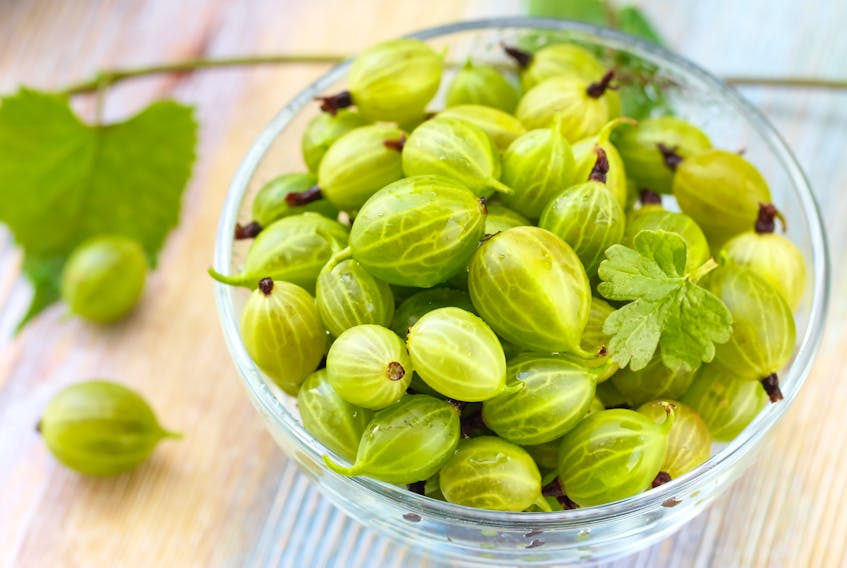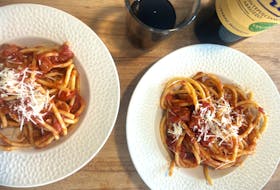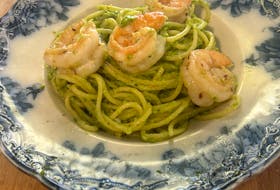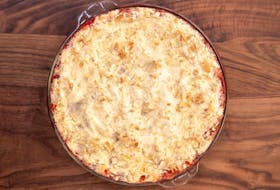NORTH WILTSHIRE, P.E.I. — Why are they called gooseberries? I have been curious about the name for most of my life and still haven’t found a satisfactory answer.
One source tells me that they were often served with roast goose. Another source says that the “goose” in the word may be derived from a Dutch or German root.
In French, it is groseille à maquereau, meaning mackerel berries, in reference to the fact that gooseberry sauce was served with mackerel in old French cuisine.
I consider gooseberries to be old-fashioned fruits. Just as farmers used to raise a variety of livestock, a few chickens, geese, pigs, and cows, so gardeners were likely to grow a variety of fruit, having a rhubarb patch, a row of raspberry canes, a few currant or gooseberry bushes and an apple tree or two.
More apt to be found in established home gardens than in commercial production, the gooseberry is a firm round berry, either pure green or with a rosy blush when ripe, and a bit too sour, in my experience, to be eaten fresh. Don’t let that – or the spiky thorns that protect the bushes it grows on– deter you. Cooked gooseberries make great jams, jellies, relishes and desserts.
If our experience is typical, gooseberry bushes are tenacious in this climate. Our little bush, decades after we planted it next to the west side of the house, continues to produce fruit for us to use every year if we’re quick enough to pick the berries before the squirrels move in. That is fine because slightly underripe gooseberries make the best jelly.
Gooseberries have an ample supply of both acid and pectin, the components that make jelly set. That means you need add only water to cook the fruit and sugar to make a tasty spread for your morning toast. I prefer the texture of jelly made without the use of commercial pectin, although it is trickier to make.
A fool, the culinary type, is a dessert made by folding together whipped cream and berries or other fruit. Gooseberry fool seems to be a classic.
Gooseberry Fool
Adapted from Nightingale, Marie: “Out of Old Nova Scotia Kitchens”. Nimbus Publishing Limited, Halifax, 1989.
1 L (1 quart) ripe gooseberries
500 mL (2 cups) water
250 mL (1 cup) sugar
500 mL (1 pint) heavy cream
- Top and stem the gooseberries and stew in water until tender.
- Press through a sieve to remove the skins.
- Add the sugar and stir.
- Whip the cream and carefully fold in the gooseberry purée.
- Pour into a glass bowl or individual sherbet glasses and chill.
At university, I was particularly interested in a course called Aesthetic and Cultural Aspects of Food. We learned about food customs from around the world, and we encountered gooseberries in the section on the British Isles. The berries were poached in sugar syrup, cooled, and arranged on a flan case, the pastry crust for a shallow tart called a flan. The poaching liquid was thickened with arrowroot flour to make a clear glaze for the flan.
That is how I learned that gooseberries can be used in their whole state, as well as being made into jelly or jam.
I’ve since found recipes for gooseberry tarts and pies. This recipe, taken from a cookbook prepared by my friend Janet’s family, comes with the following recommendation: “It has been said by the Lobo township locals that people would ‘kill’ for a piece of Jean’s gooseberry pie at their annual community picnic at Poplar Hill, Ont.”
Gooseberry Pie
Adapted from Carruthers Henderson Clan Cookbook. June 2000.
750 mL (3 cups) fresh gooseberries
375 mL (1½ cups) white sugar
45 mL (3 tbsp) quick cooking tapioca
1 mL (⅛ tsp) salt
25 mL (2 tbsp) butter or margarine
Pastry for a 23 cm (9 inch) double crust pie
- Crush 175 mL (¾ cup) of the gooseberries and add to sugar, tapioca, and salt.
- Stir in remaining berries.
- Cook until thickened.
- Turn into pastry-lined pie pan.
- Dot with butter.
- Adjust top crust and flute edges.
- Bake in hot oven, 220°C (425 F) for 35-45 minutes.
Like most berries, gooseberries freeze well. For easy pouring and measuring, freeze washed berries, with stems and blossom ends removed, in a single layer on a tray until firm, and then pack in airtight containers.
Margaret Prouse, a home economist, can be reached by writing her at RR#2, North Wiltshire, P.E.I., C0A 1Y0, or by email at [email protected].









